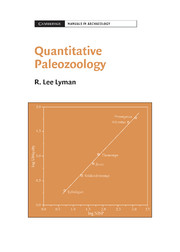Book contents
- Frontmatter
- Contents
- List of figures
- List of tables
- Preface
- 1 Tallying and Counting: Fundamentals
- 2 Estimating Taxonomic Abundances: NISP and MNI
- 3 Estimating Taxonomic Abundances: Other Methods
- 4 Sampling, Recovery, and Sample Size
- 5 Measuring the Taxonomic Structure and Composition (“Diversity”) of Faunas
- 6 Skeletal Completeness, Frequencies of Skeletal Parts, and Fragmentation
- 7 Tallying for Taphonomy: Weathering, Burning, Corrosion, and Butchering
- 8 Final Thoughts
- Glossary
- References
- Index
1 - Tallying and Counting: Fundamentals
Published online by Cambridge University Press: 05 June 2012
- Frontmatter
- Contents
- List of figures
- List of tables
- Preface
- 1 Tallying and Counting: Fundamentals
- 2 Estimating Taxonomic Abundances: NISP and MNI
- 3 Estimating Taxonomic Abundances: Other Methods
- 4 Sampling, Recovery, and Sample Size
- 5 Measuring the Taxonomic Structure and Composition (“Diversity”) of Faunas
- 6 Skeletal Completeness, Frequencies of Skeletal Parts, and Fragmentation
- 7 Tallying for Taphonomy: Weathering, Burning, Corrosion, and Butchering
- 8 Final Thoughts
- Glossary
- References
- Index
Summary
Early in the twentieth century, paleontologist Chester Stock (1929) was, as he put it, faced with “recording a census” of large mammals from the late Pleistocene as evidenced by their remains recovered “from the asphalt deposits of Rancho La Brea,” in Los Angeles, California. Paleontologist Hildegarde Howard (1930) was faced with a similar challenge with respect to the bird remains from Rancho La Brea. Stock and Howard could have merely listed the species of mammals and the species of birds, respectively, that were represented by the faunal remains they had – they could have constructed an inventory of taxa – but they chose to do something more informative and more analytically powerful. They tallied up how many individuals of each species were represented by the remains – they each produced a census. The quantitative unit they chose became known as the minimum number of individuals, or MNI, a unit that was quickly (within 25 years) adopted by many paleozoologists. We will consider this unit in some detail in Chapter 2, but here it is more important to outline how Stock and Howard defined it and why they decided to provide a census rather than an inventory of mammals and an inventory of birds.
Stock (1929:282) stated that the tally or “count” of each taxon was “determined by the number of similar parts of the internal skeleton as for example the skull, right ramus of mandible, left tibia, right scaphoid. In many cases the total number of individuals for any single group [read taxon] is probably a minimum estimate.”
- Type
- Chapter
- Information
- Quantitative Paleozoology , pp. 1 - 20Publisher: Cambridge University PressPrint publication year: 2008



